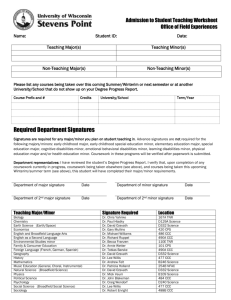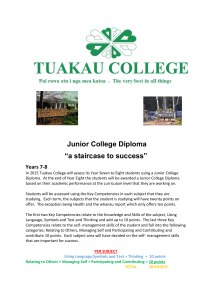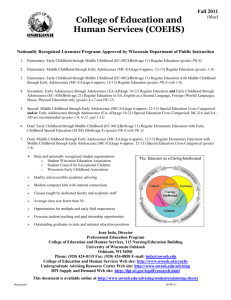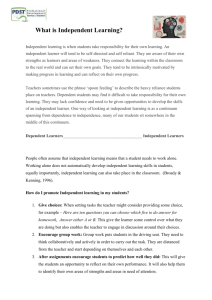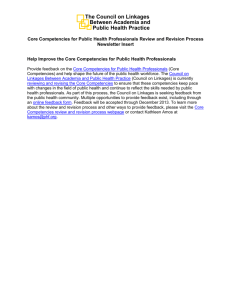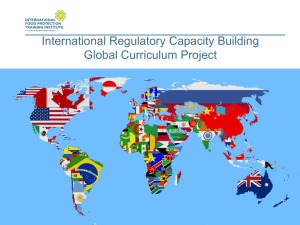Broadfield Curriculum Overview 2013
advertisement
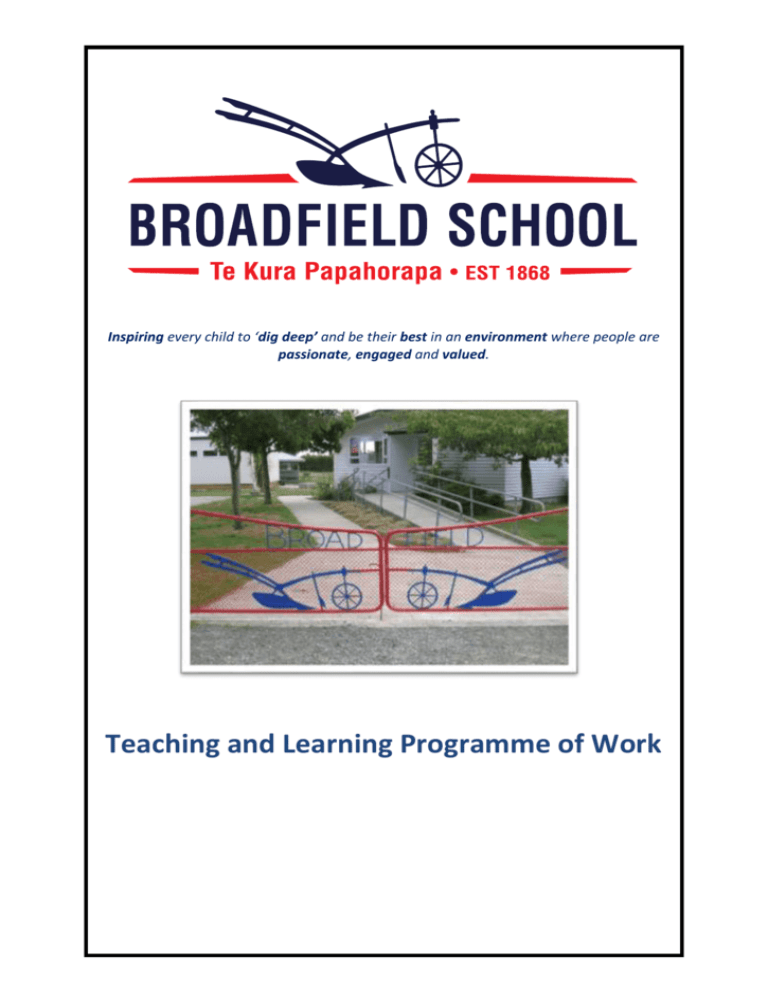
Inspiring every child to ‘dig deep’ and be their best in an environment where people are passionate, engaged and valued. Teaching and Learning Programme of Work Vision A school’s vision briefly describes the future the school community sees for itself, and what students will be like when they are confident, connected, actively involved, lifelong learners. Our Vision Statement Inspiring every child to ‘dig deep’ and be their best in an environment where people are passionate, engaged and valued. Motto “Dig Deep” This motto stems from our Vision and relates to our school Logo of the plough – we ‘dig deep’ to be our best in all we do. This is in the classroom, using the key competencies, living the school values and on the sports field. Our Learning and Inquiry Cycle Discover, Learn, Excel, Grow is our Learning and Inquiry Cycle. Discover – I am finding out what I need to learn and about myself. I need help and that’s ok. Learn – I am building and practicing my understanding. I’m on the way. Excel – I am doing well. I am successful. Grow – How can I be better? What is the next step for me? (Reflection) At Broadfield we focus on developing children who are: Happy in themselves, in what they do and with how they act Environmentally literate Working and learning – literate and numerate Resourceful and resilient Enthusiastic contributors Thinkers and dreamers Informed decision-makers Able to relate well to other people Effective communicators Effective community members (family, whanau, school, country, world) Active seekers, users and creators of knowledge Who are passionate for continuing learning (for life) The Broadfield “Story” The main symbol for our school is the single-furrow horse-drawn plough synonymous with the early farming lifestyle of the Broadfield area. The plough represents the need for students to cultivate the mind and sow the seeds for success while growing in to life-long learners. The school name in Maori is Te Kura Papa Horapa or land spread out as in “Broadfield”. Our motto is Discover Learn Excel Grow. A child comes to school to discover new things and begins to learn. As the child develops in confidence and skill they begin to excel. They continue to grow their learning to new levels and continue to be life-long learners. Classroom Names At Broadfield each classroom is called a learning community (that is what happens in them) and is identified by a special icon we developed in association with Ngati Moki Marae at Taumutu. Te Waihora (Lake Ellesmere) – the local lake we identify with. It means water spread out. Te Waihora is well-known for mahinga kai such as: tuna, patiki, awa, manu, harakeke, pingao, raupo and paru. Waikirikiri (Selwyn River) – the local river we identify with is a braided gravelly (wai = water, kirikiri = gravelly) stream. The lower reaches of Waikirikiri is one of the principal tributaries that flow into Te Waihora. It is an important source of mahinga kai. Te Ahu Patiki (Mt Herbert on Banks Peninsula) our “maunga” can be seen from our playground. Te Ahu Patiki means “shaped like a flounder or like a stack of flounders”. Harakeke (NZ Flax). This plant was very important to Maori. It grows around the area. We chose this as it represents strength and determination and resilience, qualities we appreciate in our children. Harakeke has a sense of nurturing – it provided many things for Maori who took care to nurture it well. Nga Kahu (Australasian Harrier Hawk). We see these birds of prey circling the playground. The bird represents soaring high as in having high expectations for learning. Te Tiritiri o te Moana – the name of our library/resource/multi-purpose rooms is in recognition of the Southern Alps that we can see in the west. Te Tiritiri o te Moana refers to the likeness of the snow-capped peaks and the swirling cloud around the tops, to the movement of the sea as it hits the shore. There are 3 special trees: a scarlet oak (75th Jubilee), blue cedar (100 yrs) and a golden elm planted for the 125th Jubilee in 1993. Principles: We believe in good pedagogical practice that reflects the principles of this teaching and learning plan. The observation of our classroom practice will be a measure of how successful this is being achieved. Professional review, in the form of collegial dialogue and planned professional learning, will be an on-going priority for the teaching team. At Broadfield our Teaching and Learning Programme will be guided by the following beliefs: All children will be challenged to achieve at their personal best. The principles of the Treaty of Waitangi and Aotearoa New Zealand’s bicultural heritage will be acknowledged. All students will have opportunities to gain knowledge of te reo Maori me ona Tikanga The diverse, multi-cultural nature of our country will be acknowledged and opportunities to learn other languages will be provided. The abilities, talents, identities, language or behaviour of students will be recognised and their learning needs will be addressed. Learning priorities will be: literacy, numeracy, the Key Competencies and acquisition of knowledge. The Broadfield Teaching and Learning Programme will be: child centred, connect with their outside lives and engages the support of whanau, families/whanau. This Teaching and Learning Programme will offer all pupils a broad education that has links within and across the learning areas, provides meaningful transitions and open sup further learning pathways. Our Teaching and Learning Programme encourages students to focus on the future by exploring topics such as sustainability, citizenship, enterprise or globalisation. Beliefs: At Broadfield we believe in: Perseverance (setting goals and trying hard) Excellence and high standards (manners, respect, pride) Working together - Open dialogue between our school and its community, close support from our whanau, parents and caregivers - a sense of community, participation and contribution Creative, critical and reflective thinking Diversity, difference and acceptance of others, Nurturing individuals Communicating openly and effectively, Listening Having a sense of humour Aroha - love, compassion, empathy, sympathy, selflessness, fairness, tolerance , respect and caring Whanaungatanga- traditions, belonging, the extended community family, feeling welcome, open door policy Values “Values are deeply held beliefs about what is important or desirable. They are expressed through the ways in which people think and act.” “Values are part of the everyday curriculum – encouraged, modelled, and explored.” The New Zealand Curriculum Ministry of Education (2007), p.9-10 The Broadfield School values are an innate part of our school. We live and breathe these through the staff, children and community. The teachers ensure that the values are taught and are upheld at all times. Their Class Descriptions, Curriculum Reflections and General Report Comments show how teachers are addressing the values within the classroom. At Broadfield School we expect teachers to help children find their passion. We include all children and value their personal identity. We develop a lifelong love of learning and set high expectations in all areas. Our 5 core school values are: Core Value This means we have an obligation to promote: Aroha caring, respect, compassion, empathy, sympathy, selflessness, fairness, tolerance, encouragement, inclusiveness meeting new challenges, try and try again, thinking deeply, never give up, look for positives, be your best, resiliant, the ‘Pit of Learning’ looking after own belongings and school property, being reliable, respect for our environment, time management, looking out for others telling the truth, building trust saying please, thank you, may I, excuse me, making eye contact*, greeting others – good morning, good afternoon etc. Giving way to adults, offering help, waiting your turn, listening, being polite and considerate, shaking hands. “Manners cost you nothing but earn you a great deal.” *when culturally appropriate Perseverance Responsibility Honesty Manners Broadfield School Behaviour Plan At Broadfield the school motto: Discover, Learn, Excel, Grow the Values, Beliefs and the KCs (especially Managing Self and Relating to Others) are included as an integral part of the behaviour management throughout the school. The object of the plan is to keep things simple, manageable and meaningful. All children are strongly encouraged to follow the rules and behave as good citizens. School Rules: There are 3 main rules which cover the broad spectrum of expectations we have for our students : Follow instructions Speak politely, use your manners and treat people kindly. Don’t touch other people or things that don’t belong to you. Steps: 1. Verbal warning – reminder of rules and expectations 2. Name on board (with letters deducted for positive behaviour) and this reverts after each break. 3. Playgroungd misdemeanours – sitting on the bench (“Benched”) for a designated time. 4. In Class misdemeanours – appropriate “in-class consequences” (e.g. reflective lines, thinking space, letter record). 5. Continued infringements – copying rules, written apology, giving value to the school (e.g. sweeping, weeding, picking up paper/plastic, restricted play area etc). 6. During or after school reflection time - Talk with the Principal to refocus on the rules and expectations. Letter home and/or meeting with parents 7. More serious incidents can result in an individual behaviour plan being set up and steps towards a stand-down can be instigated. The school expectations of behaviour in and out of class are that children: Move around the school quietly and respectfully – knock on doors Greet others by looking in the eye* and saying “Good morning Mrs …” Shake, take, look, thank when receiving certificates Use manners Give way to adults at doorways Say, “Excuse me” when waiting for someone’s attention Not talking over the teacher or peers Answer ‘Yes’ and ‘No’ with a one word response e.g. roll calls Respect for school property (including rubbish) Pastoral Notes Documentation of incidents will occur when step 4 is reached or there has been a serious incident such as physical outbursts. Playground incidents are dealt with by the duty teacher unless serious. Key Competencies The New Zealand Curriculum identifies five key competencies. People use these competencies “to live, learn, work, and contribute as active members of their communities.” The New Zealand Curriculum Ministry of Education (2007), p.12 Developing the Learners’ Qualities across all learning activities and programmes, enables them to function in their fast-changing world and to develop the skills for lifelong learning. “In practice, the key competencies are most often used in combination. When researching an issue of interest, for example, students are likely to need to: set and monitor personal goals, manage timeframes, and reflect on and respond to ideas they encounter (managing self); interact, share ideas and negotiate with a range of people (relating to others); call on a range of communities for information and use that information as a basis for action (participating and contributing); analyse and consider a variety of possible approaches to the issue at hand (thinking); create texts to record and communicate ideas, using language and symbols appropriate to the relevant learning area(s) (using language, symbols, and texts).” The New Zealand Curriculum Ministry of Education (2007), p.3 The Key Competencies are: Thinking Using language, symbols, and texts Managing self Relating to others Participating and contributing The 5 Key Competencies at Broadfield are a foundation for all teaching and learning activities. They are the framework used for developing successful learners. The attributes conveyed by these competencies are a focus of every learning area. We have written them in terms of what children will understand. Thinking Children who are thinkers have intellectual curiosity. They are able to: Think critical Listen actively for understanding Know about knowing (metacognitive processes) Actively find, use and create knowledge Make sense of information, ideas and experiences Think creatively Make decisions (good choices) Shape their actions Reflect on their own learning Ask questions Think about and challenge ideas and theories Using Language, Symbols and Texts Children who are competent users of language, symbols and texts can: Make meaning of the contents in which language is expressed Recognise how the choice of language, symbols or texts can change the way people understand and respond to communication Confidently explain and use words, numbers, images, movement, metaphor and technologies in a range of situations Use OTC confidently to access and provide information and to communicate with others. Managing Self Children who are good self-managers are capable learners with a “can-do” attitude. They: Think before acting Stay on task Plan work Keep trying Make good choices Cope with change Set goals Are organised Listen and process Follow instructions Are able to work by themselves or in a group Do their best Finish work on time Set high standards Self-assess Use time well Manage projects and resources Look after their own and other people’s possessions. Relating to Others Being able to relate successfully to others is particularly important in the school setting. When children are relating well to other people they: Can listen actively Know when to co-operate (follow instructions) Know when to complete (really work hard to achieve) Are keen to learn new things Are able to work together well Can share ideas and accept those of others Use different ways of thinking Participating and Contributing At Broadfield we value collegiality and a sense of community where participating and contributing is an integral part. When children are participating and contributing they can: Show a sense of belonging (learning community, school community, Broadfield community, Aotearoa/NZ, world) Contribute ideas Try new activities or new ways of doing things Be sharing and caring Be a good group member Celebrate their own and other people’s success Play fairly and be a good sport Effective Teaching and Learning at Broadfield School At Broadfield teachers work with a collaborative, team approach to teaching and learning in order to deliver a balanced, skills-based curriculum with a local focus. Wherever possible meaningful contexts and experiences that relate to life will be integrated into teaching programmes. We will do this by: Creating a supportive learning environment Encouraging reflection and thinking about the learning Using Deliberate Acts of Teaching (DAT’s) Making learning relevant, challenging and child centred Focusing on student engagement in a collaborative classroom learning community Integrating new learning with what is already understood so that students are able to make connections and apply prior knowledge Providing opportunities for learners to experience new ideas a number of times and in a variety of contexts and ways including the use of ICT and e-learning Putting in place effective formative assessment processes that: a) provide students with meaningful feedback on their progress and achievement b) inform teaching and learning Using an inquiry approach to teaching and learning where both teachers and students such questions as: “What do I need to know/do?” “What do I need to change?” “What are the next steps?” “What are the learning goals?” “What will the success criteria be?”
